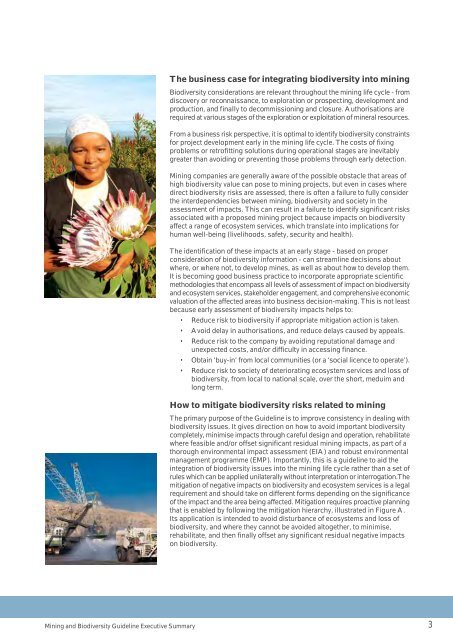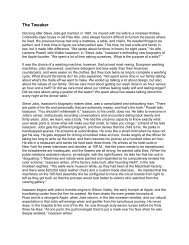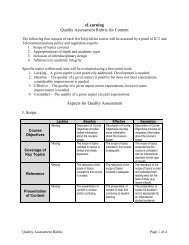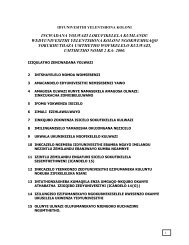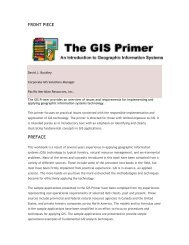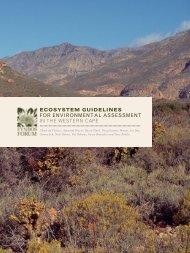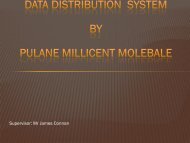Mining and Biodiversity Guideline Executive Summary
Mining and Biodiversity Guideline Executive Summary
Mining and Biodiversity Guideline Executive Summary
You also want an ePaper? Increase the reach of your titles
YUMPU automatically turns print PDFs into web optimized ePapers that Google loves.
The business case for integrating biodiversity into mining<br />
<strong>Biodiversity</strong> considerations are relevant throughout the mining life cycle - from<br />
discovery or reconnaissance, to exploration or prospecting, development <strong>and</strong><br />
production, <strong>and</strong> finally to decommissioning <strong>and</strong> closure. Authorisations are<br />
required at various stages of the exploration or exploitation of mineral resources.<br />
From a business risk perspective, it is optimal to identify biodiversity constraints<br />
for project development early in the mining life cycle. The costs of fixing<br />
problems or retrofitting solutions during operational stages are inevitably<br />
greater than avoiding or preventing those problems through early detection.<br />
<strong>Mining</strong> companies are generally aware of the possible obstacle that areas of<br />
high biodiversity value can pose to mining projects, but even in cases where<br />
direct biodiversity risks are assessed, there is often a failure to fully consider<br />
the interdependencies between mining, biodiversity <strong>and</strong> society in the<br />
assessment of impacts. This can result in a failure to identify significant risks<br />
associated with a proposed mining project because impacts on biodiversity<br />
affect a range of ecosystem services, which translate into implications for<br />
human well-being (livelihoods, safety, security <strong>and</strong> health).<br />
The identification of these impacts at an early stage - based on proper<br />
consideration of biodiversity information - can streamline decisions about<br />
where, or where not, to develop mines, as well as about how to develop them.<br />
It is becoming good business practice to incorporate appropriate scientific<br />
methodologies that encompass all levels of assessment of impact on biodiversity<br />
<strong>and</strong> ecosystem services, stakeholder engagement, <strong>and</strong> comprehensive economic<br />
valuation of the affected areas into business decision-making. This is not least<br />
because early assessment of biodiversity impacts helps to:<br />
• Reduce risk to biodiversity if appropriate mitigation action is taken.<br />
• Avoid delay in authorisations, <strong>and</strong> reduce delays caused by appeals.<br />
• Reduce risk to the company by avoiding reputational damage <strong>and</strong><br />
unexpected costs, <strong>and</strong>/or difficulty in accessing finance.<br />
• Obtain ‘buy-in’ from local communities (or a ‘social licence to operate’).<br />
• Reduce risk to society of deteriorating ecosystem services <strong>and</strong> loss of<br />
biodiversity, from local to national scale, over the short, meduim <strong>and</strong><br />
long term.<br />
How to mitigate biodiversity risks related to mining<br />
The primary purpose of the <strong>Guideline</strong> is to improve consistency in dealing with<br />
biodiversity issues. It gives direction on how to avoid important biodiversity<br />
completely, minimise impacts through careful design <strong>and</strong> operation, rehabilitate<br />
where feasible <strong>and</strong>/or offset significant residual mining impacts, as part of a<br />
thorough environmental impact assessment (EIA) <strong>and</strong> robust environmental<br />
management programme (EMP). Importantly, this is a guideline to aid the<br />
integration of biodiversity issues into the mining life cycle rather than a set of<br />
rules which can be applied unilaterally without interpretation or interrogation.The<br />
mitigation of negative impacts on biodiversity <strong>and</strong> ecosystem services is a legal<br />
requirement <strong>and</strong> should take on different forms depending on the significance<br />
of the impact <strong>and</strong> the area being affected. Mitigation requires proactive planning<br />
that is enabled by following the mitigation hierarchy, illustrated in Figure A.<br />
Its application is intended to avoid disturbance of ecosystems <strong>and</strong> loss of<br />
biodiversity, <strong>and</strong> where they cannot be avoided altogether, to minimise,<br />
rehabilitate, <strong>and</strong> then finally offset any significant residual negative impacts<br />
on biodiversity.<br />
<strong>Mining</strong> <strong>and</strong> <strong>Biodiversity</strong> <strong>Guideline</strong> <strong>Executive</strong> <strong>Summary</strong><br />
3


